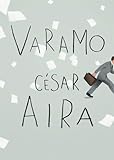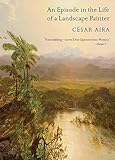 César Aira is probably as known for the sheer volume of his literary output as he is for any individual masterpiece in his immense oeuvre. Aira publishes an average of two novels a year, in a career that has produced over 70 books, a staggering feat of perpetual fecundity. His newly translated novella Varamo takes place over the course of one evening in 1923, and follows the exploits of a government worker in Panama. After leaving his office with a pair of counterfeit bills received as his monthly salary, the novel’s eponymous character, through a series of uncanny circumstances that stem from the anxiety that the possession of the counterfeit currency engenders, ends up writing, in the hours before dawn, “that celebrated masterpiece of modern Central American poetry, The Song of the Virgin Boy.”
César Aira is probably as known for the sheer volume of his literary output as he is for any individual masterpiece in his immense oeuvre. Aira publishes an average of two novels a year, in a career that has produced over 70 books, a staggering feat of perpetual fecundity. His newly translated novella Varamo takes place over the course of one evening in 1923, and follows the exploits of a government worker in Panama. After leaving his office with a pair of counterfeit bills received as his monthly salary, the novel’s eponymous character, through a series of uncanny circumstances that stem from the anxiety that the possession of the counterfeit currency engenders, ends up writing, in the hours before dawn, “that celebrated masterpiece of modern Central American poetry, The Song of the Virgin Boy.”

 Like some of those fabricated writers pulled from the South American air by Roberto Bolaño in Nazi Literature in the Americas or those fictional Bartleby’s that Spanish novelist Enrique Vila-Matas created to accompany the real writers who preferred not to in Bartleby & Co., Aira’s Varamo has a story that seems too good to be true, and is. Varamo is a Kafkaesque civil servant and, in his spare time, an amateur embalmer — but one thing he is not is a writer, for “never, in all his fifty years, had he written or felt any inclination to write a single line of poetry, nor would he ever again.” Though Varamo only creates one work of art, he does so feverishly, over the course of that evening, and thus embodies, if not Aira’s unending output, at least his method of fuga hacia adelante (which roughly translates to: “fleeing forward”).
Like some of those fabricated writers pulled from the South American air by Roberto Bolaño in Nazi Literature in the Americas or those fictional Bartleby’s that Spanish novelist Enrique Vila-Matas created to accompany the real writers who preferred not to in Bartleby & Co., Aira’s Varamo has a story that seems too good to be true, and is. Varamo is a Kafkaesque civil servant and, in his spare time, an amateur embalmer — but one thing he is not is a writer, for “never, in all his fifty years, had he written or felt any inclination to write a single line of poetry, nor would he ever again.” Though Varamo only creates one work of art, he does so feverishly, over the course of that evening, and thus embodies, if not Aira’s unending output, at least his method of fuga hacia adelante (which roughly translates to: “fleeing forward”).
Aira’s fuga hacia adelante technique is a method of writing that avoids revision. What he has written remains, and the next day’s task is to take what he wrote the previous day, and, whatever box he has written himself into, improvise a way out of by fleeing forward through propulsive improvisation. This concept of improvisation is central to Aira’s work, and takes a thematic forefront in Varamo:
Intending to be natural was, in itself, contradictory and self-defeating. In his case, it was condemned to failure from the outset, because if he intended to improvise his course of action, he would have to act as if he were really improvising, and at the same time he would, also, really be improvising, which was no more feasible than moving in two opposite directions at the same time.
This is precisely what Varamo does: it moves in two opposite directions at the same time. The titular character’s inspired night, which begins, as only an Aira novel could, with counterfeit bills and an undead fish, and ends with an avant-garde poem, reads as an explication of the fuga hacia adelante method:
In the interval between that moment and the dawn of the following day, ten or twelve hours later, he completed the composition of a long poem, from the initial decision to write it up to the final period, after which there were no further additions or corrections.
And yet, throughout the book, it becomes obvious that Aira is not merely using Varamo’s story as a guidebook describing his literary method, but rather that Aira is mocking these radical ideas of textual production in the same sentences in which he is defending them.
In addition to this complicated two-way view of textual production, Aira also posits an equivalent muddle of interpretative technique. As an improvised and counterfeit example of literary criticism (of a non-existent text by a fabricated writer), Varamo idealizes the notion that a true account of the producing mind can be discovered through a thorough reading of the text which that mind produced. Halfway into the 88-page novella, the narrator embarks on a lengthy aside, proclaiming that Varamo is “a work of literary history, not a fiction,” and explaining why the “free indirect style” is useful in his presentation of the “facts” of that evening in Varamo’s life:
But our invasion of Varamo’s consciousness is not magical or even imaginative or hypothetical. It is a historical reconstruction. The difference is that we have presented it backwards, starting with the final results of our research. All the circumstantial details with which we have been coloring the story of the character’s day and making it credible have been deduced (in the most rigorous sense of the word) from the poem that he finally wrote, which is the only document that has survived.
However, the obvious impossibility and imprecision of such a herculean task undermines this proposition, and instead of critical sincerity, humor pervades the pages. After all, how could it be that “all the critic has to do is translate each verse, each word, backwards, into the particle of reality from which it sprang?” Could a “true” history ever be created through interpretation by working backwards, into the particle of reality from which it sprang? It depends on a definition of the word “true,” as later a definition of the word “realism” becomes important in an interpretation of Varamo as well.
Jorge Luis Borges and (Aira’s mentor) Osvaldo Lamborghini are the touchstones here, of course, but the most interesting influence may be found in the way the writing of Polish émigré Witold Gombrowicz, who lived nearly half his life in Aira’s home country of Argentina, sneaks into Aira’s internal landscapes. A reimagined Gombrowiczian obsessional fantasy underpins Aira’s Varamo. Bolaño, who called Aira “one of the three or four best writers working in Spanish today,” also saw this Gombrowicz connection, writing: “His novels seem to put the theories of Gombrowicz into practice, except, and the difference is fundamental, that Gombrowicz was the abbot of a luxurious imaginary monastery, while Aira is a nun or novice among the Discalced Carmelites of the Word.”

 Varamo has been cast as a lesser work in relation to some of the other Aira already in English translation — namely How I Became a Nun and An Episode in the Life of a Landscape Painter — and though this may be true, to overlook Varamo would be a mistake.
Varamo has been cast as a lesser work in relation to some of the other Aira already in English translation — namely How I Became a Nun and An Episode in the Life of a Landscape Painter — and though this may be true, to overlook Varamo would be a mistake.
As other great Spanish-language writers like Borges, Bolaño, and Vila-Matas have done, Aira shapes new worlds with his fiction — but he does this in a unique style that is full of infinite possibility. As is written in Varamo, “Everything was possible, as in a world about to take shape.” Aira sees the world, and reality, in his own idiosyncratic way, and fashions the worlds of his books through the filter of that perspective, but as with all great writing, there is still an important component connecting it to reality, to “realism.” Though something like “free indirect discourse” may seem like a move toward the “magical,” and away from conventional realism, it is merely an attempt to get at a “truer” reality. This is the kind of “realism” we find in the novels of César Aira:
Perhaps, said one, “the time has come for realism.” The other two disagreed vehemently: the time for realism would never come. To which the reply, and here they were all in agreement again, was that it depended on how realism was defined. The time for realism in that sense (to be defined) was always now.








